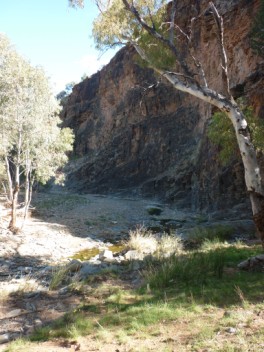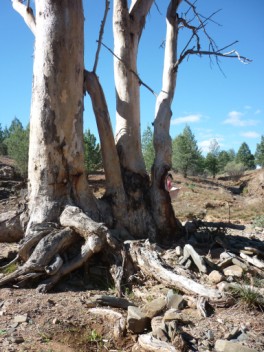NSW Rogaining Association
"Your Guide to Rogaining in NSW"
The 2012 Australian Rogaining Championships rogaine, organised by the South Australian Rogaining Association was held in the Flinders Ranges SA.
Results are here.
The Australian University Championships were held in conjunction with this event. The NSW team was Kim van Netten and Andrew Morris. Photos they took while out on the course are here.
Here is their report ...
Our rogaining adventure began the same as a lot of people
travelling to the Australian Champs, on a bus from Adelaide up north
to the Flinders Ranges. It was a long bus ride in which we got to
talk to other competitors and take in the sights. After about 6
hours on the road we arrived (at dusk) at the edge of the Flinders
Ranges. The mountains, glowing red in the sun set, made the whole
bus fall silent. You could really feel the nervous energy of the bus
rise as we were greeted with what seemed like endless watercourses,
ridges, spurs and knolls (which all looked the same!) and everyone
started to realise the undulating and perhaps navigationally
difficult event they were in for.
The next morning when the maps were handed out it was exactly as we
had suspected – steep, riddled with watercourses and gullies and
covering a very large area. As Andrew and I had never done a rogaine
in the Flinders Ranges before (in fact it was Andrew’s first 24 hr
event) we were not sure what to expect , especially on the 1: 33 333
map, which neither of us had ever used before. In the end we decided
to head down to the south-east section of the map first, which
appeared to be less steep than the northern part and not too
difficult navigation wise, and then try and do a loop around the map
(in a clockwise direction).
The first six hours of the course passed without any major
issues, we even managed to catch a glimpse of an emu watching down
from the top of a hill. We found, however, that we were a little
behind where we thought we would be a certain time check points
(i.e. 3 hours and 6 hours). I think we just didn’t realise how far
it was between each control as we were so used to 1: 25 000 maps! We
also made the mistake of contouring/climbing up and over instead of
taking the watercourse option as a route choice which slowed us
down. We did finally learn, however, that contouring doesn’t work
because of the steepness of the hills and the unstable footing (due
to the shale) and that even what looks like a small hill on the map
is indeed a very decent climb. The dry watercourses, however, were
amazing; filled with old (and very large) river red gums and lined
with steep rock gorges. Some were so wide they were like bush
highways and usually easier to walk along than the hillsides.
As night fell we were excited about the prospect of navigating under
the full (super) moon light. It was an awesome place to walk at
night in such lovely conditions. The moonlight was so bright that
the landforms were still quite easy to see and we barely even needed
our torches. We reached water drop 5 at about 7 pm and it was at
this point I decided to take off my shoes and work out why my feet
were starting to become painful. I found, to my disappointment, that
huge blisters had already formed on the back of my heels even though
I had strapped them. There was nothing I could do so I just applied
more strapping and we were underway again. As we continued to walk,
however my feet became more and more painful and just two controls
later we had to modify our route so we could have a much needed stop
at the Hash House.
We had two hours of sleep at the Hash House and were underway again
at 5 am. The stop had actually helped my feet more than I had
expected and I managed to get a few more hours out of them in the
light of the second day. We used this time to do a small loop to the
north of the Hash House in a very steep area of the map. It was
pleasant none-the-less and we saw another small group of emus (along
with a lot of kangaroos). Although as the morning went on my feet
started to become painful once again and eventually we just had to
hobble back to the main road on the map and walk slowly back to the
HH, finishing with plenty of time to spare.
Overall we had a really great time and are thankful to the
organisers who must have spent countless hours in planning and
setting for a rogaine which would have been a logistical nightmare.
It is really an amazing area and was well worth the trip. We want to
extend special congratulations to the winning teams, especially to
the first University team from the ACT, who actually placed second
overall. We have learned a lot of valuable lessons (most importantly
– what shoes not to wear) and are looking forward to the next event.
Also a special thanks to the NSW Rogaining Association and the Nigel
Aylott Memorial Sports Foundation (NAMSF) for giving us this
opportunity.
Kim van Netten & Andrew Morris
This report is available here as a PDF.


